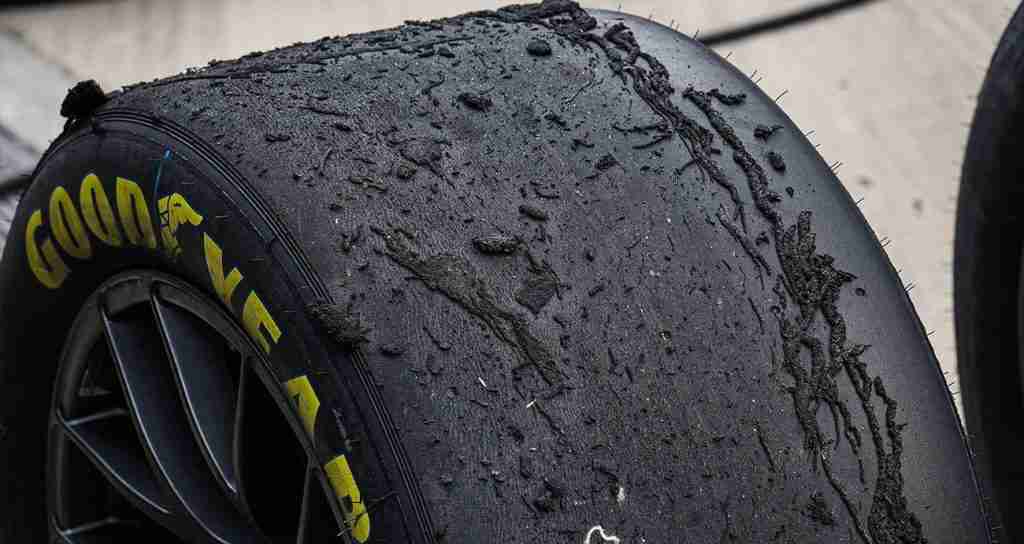Brittney Wilbur | NASCAR.com
Goodyear tires were the topic of many NASCAR conversations Monday after an exciting and unpredictable classic Sunday afternoon at Bristol Motor Speedway.
Severe tire wear around the Food City 500’s 0.533-mile track upset everyone, including Goodyear, its racing director Greg Stucker told SiriusXM NASCAR Radio Monday afternoon. The result was a thrilling battle in tire management, but Goodyear is looking back at what led to Sunday’s upset.
MORE: Recap of Hamlin’s win at Bristol
The tires used in Sunday’s race conformed to the same tire code that Goodyear provided to the teams in September, leading to more confusion as to why they performed so differently on Sunday compared to the playoff race last fall.
“Yesterday was a drastic change from what we expected,” Stucker said Monday on SiriusXM. “The goal now is just to try to understand why this happened, but I think we’re approaching it in a very positive way.”
This positive reaction stems from both fan sentiment, driver sentiment and NASCAR sentiment. John Probst, NASCAR’s senior vice president of racing innovation and development, announced Sunday’s race. “one of the best short track races I have ever seen.”
“For about a year,” Stucker said, “the drivers have been pushing us to be more aggressive in our recommendations, to be more aggressive with tire wear and to let them manage the tires during the run. And I think that’s what we saw yesterday Tire management was key. It was probably the most important thing in the race.
“Now I’m not claiming we have tire wear as bad as we saw yesterday at every race. But I think this is a place where we could draw a line in the sand and I think we can learn from it.
The next steps have already begun, focusing on why the tires wore out after around 50 laps on Sunday, instead of a full 130 laps in September.
“I already mentioned that this was the same tire we used in September last year. They are the same D numbers; it’s a different production line,” Stucker said. “So we don’t take anything for granted. It’s the same spec, but is there anything that could stand out and create a difference? A few drivers after the race said to us, “Look, you can’t convince me it was the same tire, the way it handles,” and we understand that. I mean, there’s no doubt the tire didn’t wear the same way. He didn’t lay rubber like in September. He just behaved differently.
“Was it because of the tire itself? Was it because of the circuit? Obviously, resin was placed on the race track in place of the PJ1 as was the case last year. We haven’t really decided yet if that could be a factor. This is something we are studying. … Is there anything they did differently to wash the race track or anything like that?
“So there’s a lot to go through. But we certainly look at each piece of the puzzle from our perspective and make sure that there is nothing in our raw materials or in our processes that could create any difference.
In the end, Stucker thanked the helmsmen and their teams for handling the situation gracefully to arrive at the checkered flag without further issue, concluding the record run in a 121-lap green flag race.
“Congratulations to the drivers,” Stucker said. “That’s what they say. Again, it was extreme yesterday, but I think what happened just reinforced what they were saying and how important it is to put some of the control of the car back in the hands of the drivers because it really makes a difference. And I say drivers, but it’s also in the hands of the team managers. The crew chiefs also had to go to work yesterday, didn’t they, and try to make adjustments with a race car so that the drivers could keep the tires underneath them. And so I think if you poll the garage, almost everyone had a really good time, even in a tough situation because it was fun driving; it was fun for the team leaders to make adjustments.
RELATED: Chemistry by Hamlin and Gabehart shine at Bristol
Stucker said there will likely be one more Goodyear tire test in Bristol before returning to the “Last Great Colosseum” in September for this year’s playoff race. But all adjustments will be made in hopes of maintaining noticeable tire wear while better understanding and anticipating tire behavior.
“With the feedback we’ve gotten and hearing some of the comments, we don’t need to go too far, I think,” Stucker said. “We don’t want to go back and go too hard. But I think we need to understand what happened, and we need to go back and try to replicate that and make sure it doesn’t happen again. We need to understand why we were surprised and what we can do about it so we can come back with an expectation of around 80% (of Sunday’s wear), come back with that in September and deliver exactly what we expect . »

